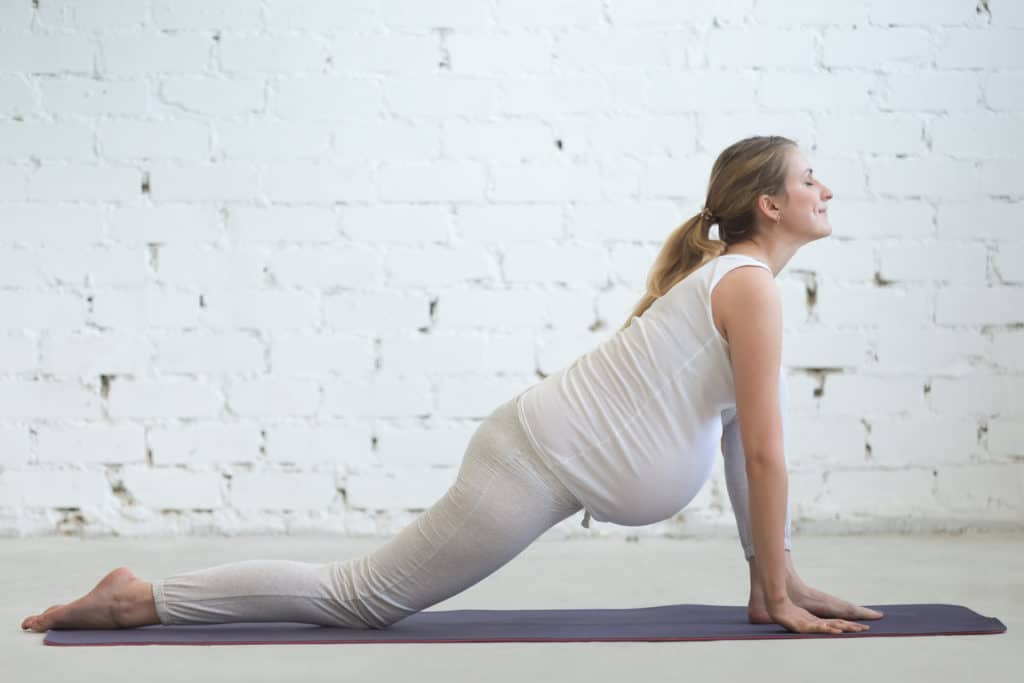Last updated: March 20, 2020

The premise behind this concern can be stated as follows:
Pregnant women have a lot of the hormone relaxin in their bodies, which softens their collagen, making them potentially hypermobile and subject to injuries due to this hypermobility. The long-held stresses of Yin Yoga are not good for them.
There is some truth to this statement: women do produce a lot of the relaxin hormone during the first trimester of pregnancy, which helps to soften their connective tissue (to allow for easier implantation of the fetus into the uterine wall and for opening space in the pelvic bowl), and then again in the days prior to labor beginning. However, this does not mean that a Yin Yoga practice cannot be healthy during these months.
Intentions are important. While pregnant, the intention in a woman’s practice should not be to go further into poses than she has ever gone before. Range of motion is not the goal now; the baby’s health and the woman’s own comfort is key. Because the connective tissues will start to become softer, it may be easy to overstress the ligaments and cartilage and possibly stretch and damage them. Whatever range of motion she had before becoming pregnant, she should be happy to stick with that—no need to try to go further.
Fortunately, the longer the pregnancy lasts, the less the mother-to-be is able to move. Her growing belly will prevent many movements. Twists do not have to be forbidden because they will naturally become shallower. Movements in the pelvis and hips, however, should be dialed back. Too much stress here, held for too long, could potential destabilize some women’s sacroiliac joints or the pubic symphysis. A general rule of thumb for pregnant students is to avoid longer holds or deep positions. Three minutes may be the maximum now.
(A similar point can be made for women who are post partum: after pregnancy is finished, it is not yet time to try to obtain greater range of motion. The body is very open now. Yin Yoga is not recommend in the first few weeks right after delivering a baby. This is a time to allow the body to knit back together. Perhaps after 6 to 8 weeks, a gentle yin-practice can begin again. Gentleness is the key. When the time is right, some yin postures can be used to gently stretch the body, as well as massage the belly and stimulate abdominal muscles in a gentle way. )
Another piece of advice: pregnant women in the 3rd trimester may want to avoid lying on their back for long periods of time. Recent evidence has shown that even 30 minutes of lying supine can reduce oxygen levels in the baby’s blood, causing decreases in heart rate variability. This is due to the compression of the inferior vena cava (the major vein returning blood to the heart). While most healthy pregnant women are quite fine lying on their backs, because there is a collateral vein (the azygos) bringing blood to heart, the fetus does notice the effect. Since Yin Yoga does involve long-held postures, the pregnant woman during her last 3 months of pregnancy may want to avoid reclined or supine postures in Yin Yoga. (See the articles in this footnote for the science behind the recommendation[1].)
The intention of the Yin Yoga practice for pregnant women is not to acquire new ranges of motion or to linger too long in each posture, but rather to be more mindful, present and attentive. Many postures can help alleviate the stresses that build up during pregnancy, and some women have found the energetic value of the practice to be quite helpful. Sarah Powers, one of the pioneers of Yin Yoga, continued her practice during her pregnancy and writes eloquently about it in her book Insight Yoga:
Among the many benefits to doing a Yin Yoga practice while pregnant is that the poses stimulate the tissues to help create more fluid mobility throughout the system, increasing the comfort in the body as it grows and changes. Stimulating the meridians in this way also contributes to a healthier organ system, another plus, because the organs are working harder during pregnancy and lactation. Because the practice serves as a needle-less acupuncture session, it can help balance a woman’s overall energy and emotions, which are naturally destabilized by the hormone infusion during this time. Last, but perhaps the most important reason to practice [Yin Yoga] is the meditative atmosphere it creates. I feel that learning or continuing to deepen into mindfulness during pregnancy is of utmost importance. In pregnancy as in motherhood, we are called on to ride the erratic emotions triggered by hormones. We need to be able to flow with difficult circumstances without prolonged inward rigidity and tension, which have a direct and immediate impact upon the fetus and child.[2]
Senior Yin Yoga teacher Diana Batts, who co-runs Yin Yoga teacher trainings, states that she would rather have pregnant women in her yin classes than other classes because it gives her more time as a teacher to attend to the students’ needs. She can help the pregnant student become more aware of her body than is possible in yang classes.
Should all pregnant women do Yin Yoga? No, of course not. But this doesn’t mean that most women will not benefit from it in a variety of ways. As always, pay attention! Don’t try for great range of motion; rather, focus instead on relaxing, opening the energy body and being present.
Return to Topics
[1] Back to basics: avoiding the supine position in pregnancy (https://www.ncbi.nlm.nih.gov/pmc/articles/PMC5309362/);
Effect of maternal position on fetal behavioural state and heart rate variability in healthy late gestation pregnancy (https://www.ncbi.nlm.nih.gov/pubmed/27871127);
The effect of supine positioning on maternal hemodynamics during late pregnancy (https://www.ncbi.nlm.nih.gov/pubmed/29772936);
The collateral venous system in late pregnancy: A systematic review of the literature (https://www.ncbi.nlm.nih.gov/pubmed/28726308);
Hemodynamic changes in women with symptoms of supine hypotensive syndrome (https://www.ncbi.nlm.nih.gov/pubmed/31856296);
[2] Sarah Powers, Insight Yoga (Boston: Shambala Publications, 2008), 36.
